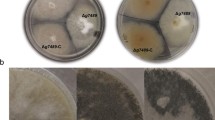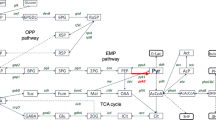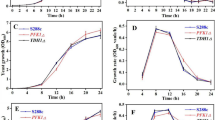Abstract
We investigated the adaptative response of S. cerevisiae in sod mutants (sod1Δ, sod2Δ and sod1Δsod2Δ) after H2O2 treatment in the stationary phase. sod2Δ and sod1Δsod2Δ demonstrated the highest levels of GSH in the control, suggesting that pathways which include GSH protect these double mutants against oxidative stress. In addition, sod1Δ and sod1Δsod2Δ had higher iron levels than the wild-type, independently of H2O2 stress. Fe levels were increased in sod2Δ following H2O2 In addition, the sod2Δ mutant was more sensitive to H2O2 treatment than the wild-type. These results suggest that sod2Δ sensibility may be associated with •OH production by the Fenton reaction. This increased iron demand in the sod2Δ mutant may be a reflection of the cells’ efforts to reconstitute proteins that are inactivated in conditions of excess superoxide. MDA levels were assayed by HPLC in these mutants. The highest MDA levels could be observed after 10mM H2O2 treatment in the sod1Δsod2Δ double mutant. After treatment with a GSH inhibitor, the MDA level was still higher in the same strain. Thus, both direct and indirect GSH pathways are involved in the protection of lipid membranes and proteins in these mutants and may constitute an adaptative response to enhanced basal oxidative damage produced by superoxide.
Similar content being viewed by others
References
Antunes F, Salvador A, Marinho HS, Alves R, Pinto RE: Lipid peroxidation in mitochondrial inner membranes I. An integrative Kinetic model. Free Radic Biol Med 21: 917–943, 1996
Wiseman H, Halliwell B: Damage to DNA by reactive oxygen and nitrogen species: role in inflammatory disease and progression to cancer. Biochem J 313: 17–28, 1996
Stadman ER, Berkett BS: Reactive oxygen-mediated protein oxidation in aging and disease. Chem Res Toxicol 10: 485–494, 1997
Smith MA, Rottkamp CA, Nunomura A, Raina AK, Perry G: Oxidative stress in Alzheimer’s disease. Biochim Biophys Acta 1502: 139–144, 2000
Brand MD, Affourtit C, Esteves TC, Green K, Lambert AJ, Miwa S, Pakay’JL Parker N: Mitochondrial superoxide: production, biological effects, and activation of uncoupling proteins. Free Radic Biol Med 37: 755–767, 2004
Levine RL, Garland D, Oliver CN, Amici A, Climent I, Lenz AG, Alm B, Shaltie LS, Stadman ER: Determination of carbonyl content in oxidatively modified proteins. Methods Enzymol 186: 464–478, 1990
Beal MF: Oxidatively modified proteins in aging and disease. Free Radic Biol Med 32: 797–803, 2002
Cambi SL, Lee P, Choi AM: The oxidative stress response. New Horiz 3: 170–182, 1995
Gralla EB, Kosman DJ: Molecular genetics of superoxide dismutases in yeast and related fungi. Adv Genet 30: 251–319, 1992
Farr SB, D’Ari R, Touati D: Oxygen-dependent mutagenesis in Escherichia Coli lacking superoxide-dismutase. Proc Natl Acad Sci USA 83: 8268–8272, 1996
Doner G, Ege A: Evaluation of digestion procedures of the determination of iron and zinc in biscuits by flame atomic absorption spectrometry. Anal Chim Acta 520: 217–222, 2004
Srinivasan C, Liba A, Imlay JA, Valentine JS, Gralla EB: Yeast lacking superoxide dismutase(s) show elevated levels of “free iron” by whole cell electron paramagnetic resonance. J Biol Chem 275: 29187–29192, 2000
Liu XF, Elashvili I, Gralla EB, Valentine JS, Lapinskas P, Culotta VC: Yeast lacking superoxide-dismutase – isolation of genetic supressors. J Biol Chem 267: 18298–18302, 1992
Yoo HY, Kim SS, Rho HM: Overexpression and simple purification of human superoxide dismutase (SOD) in yeast and its resistance to oxidative stress. J Biotechnol 68: 29–35, 1999
Gralla EB, Valentine JS: Null mutants of Saccharomyces cerevisiae Cu, Zn superoxide dismutase: characterization and spontaneous mutation rates. J Bacteriol 173: 5918–5920, 1991
Manfredini V, Roehrs R, Peralba MCR, Henriques JAP, Saffi J, Ramos ALLP, Benfato MS: Glutathione peroxidase induction protects Saccharomyces cerevisiae sod1Δsod2Δ double mutants against oxidative damage. Braz J Med Biol Res 37: 159–165, 2004
Shemann F, Fink GR, Hicks JB: Methods in yeast genetics. Cold Spring Harbor, New York, 1986.
Longo VD, Gralla EB, Valentine JS: Superoxide dismutase activity is essential for stationary phase survival in Saccharomyces cerevisiae. J Biol Chem 271: 12275–12280, 1996
Fortuniak A, Zadzinski R, Bilinski T, Bartosz G: Glutathione depletion the yeast Saccharomyces cerevisiae. Biochem Mol Biol Int 38: 901–910, 1996
Zadzinski R, Fortuniak A, Bilinski T, Grey M, Bartosz G: Menadione toxicity in Saccharomyces cerevisiae cells: activation by conjugation with glutathione. Biochem Mol Biol Int 44: 747–759, 1998
Akerboom TPM, Sies H: Assay of glutathione disulfide, and glutathione mixed disulfides in biological samples. Methods Enzymol 77: 373–382, 1981
Esterbauer H, Cheeseman KH: Determination of aldehylic lipid peroxidation products: malonaldehyde and 4-Hydroxylnonenal. Methods Enzymol 186: 407–431, 1990
Bradford M: A rapid and sensitive method for the quantitation of microgram quantities of protein utilizing the principle of protein-dye binding. Anal Biochem 72: 248–254, 1976
Jakubowski W, Bilinski T, Bartosz G: Oxidative stress during of stationary cultures of the yeast Saccharomyces cerevisiae. Free Radic Biol Med 28: 659–664, 2000
Ravichandran V, Seres T, Moriguchi T, Thomas JA, Johnston RB: S-Thiolation of Glyceraldehyde–3-phosphate dehydrogenase induced by the phagocytosis-associated respiratory burst in blood monocytes. J Bio Chem 269: 25010–25015, 1994
Dhindsa RS: Glutathione Status and protein-synthesis during drought and subsequent rehydration in tortula-ruralis. Plant Phys 83: 816–919, 1987
Schuppekoistinen I, Gerdes R, Moldeus P, Cotgreave IA: Studies on the reversibility of protein S-Thiolation in human endothelial-cells. Arch Biochem Biophys 315: 226–234, 1994
Lapshina EA, Bartosz G: What determines the antioxidant potential of yeast cells. Biochem Mol Biol Int 37: 949–957, 1995
Spooren AAMG, Evelo CTA: Hydroxylamime treatment increases glutathione-protein and protein-protein binding in human erythrocytes. Blood Cell Mol Dis 17: 323–336, 1997
Wernerman J, Luo JL, Hammarqvist F: Glutathione Status in critically-ill patients; possibility of modulation by antioxidants. Proc Nutr Soc 58: 677–680, 1999
Hirrlinger J, Schulz JB, Dringen R: Effects on dopamine on the glutathione metabolism of cultured astroglial cells implications for Parkinson’s disease. J Neurochem 82: 458–467, 2002
Schmidt M, Grey M, Brendel M: A microbiological assay for the quantitative determination of glutathione. BioTechnol 21: 881–886, 1996
De Freitas JM, Liba A, Meneghini R, Valentine JS, Gralla EB: Yeast lacking Cu–Zn Superoxide dismutase show altered iron homeostasis. J Biol Chem 275: 11645–11649, 2000
Liochev SI, Fridovich I: The role of O2− in the production of OH•: in vitro and in vivo. Free Radic Biol Med 16: 29–33, 1994
Fridovich I: Superoxide radical and superoxide dismutases. Annu Ver Biochem 64: 97–112, 1995.
Cabiscol E, Piulats E, Ecahvel P, Herrero E, Ros J: Oxidative stress promotes specific protein damage in Saccharomyces cerevisiae. J Biol Chem 275: 27393–27398, 2000
Blackburn AC, Doe WF, Buffinton GD: Protein carbonyl formation on mucosal protein in vitro and dextran sulfate-induced colitis. Free Radic Biol Med 27: 262–270, 1999
Inoue Y, Matsuda T, Sugiyama K, Izawa S, Kimura A: Genetic analysis of glutathione peroxidase in oxidative stress response of Saccharomyces cerevisiae. J Biol Chem 274: 27002–27009, 1999
Avery AM, Avery SM: Saccharomyces cerevisiae expresses three phospholipid hydroperoxide glutathione peroxidases. J Biol Chem 276: 33730–33735, 2001
Tsuzi D, Maeta K, Takatsume Y, Izawa S, Inoue Y: Regulation of the yeast phospholipid hydroperoxide glutathione peroxidase GPX2 by oxidative stress is mediated by Yap1 and Skn7. FEBS Lett 565: 148–154, 2004
Author information
Authors and Affiliations
Corresponding author
Rights and permissions
About this article
Cite this article
Manfredini, V., Martins, V.D., Peralba, M.d.C.R. et al. Adaptative response to enhanced basal oxidative damage in sod mutants from Saccharomyces cerevisiae. Mol Cell Biochem 276, 175–181 (2005). https://doi.org/10.1007/s11010-005-4058-0
Received:
Accepted:
Issue Date:
DOI: https://doi.org/10.1007/s11010-005-4058-0




